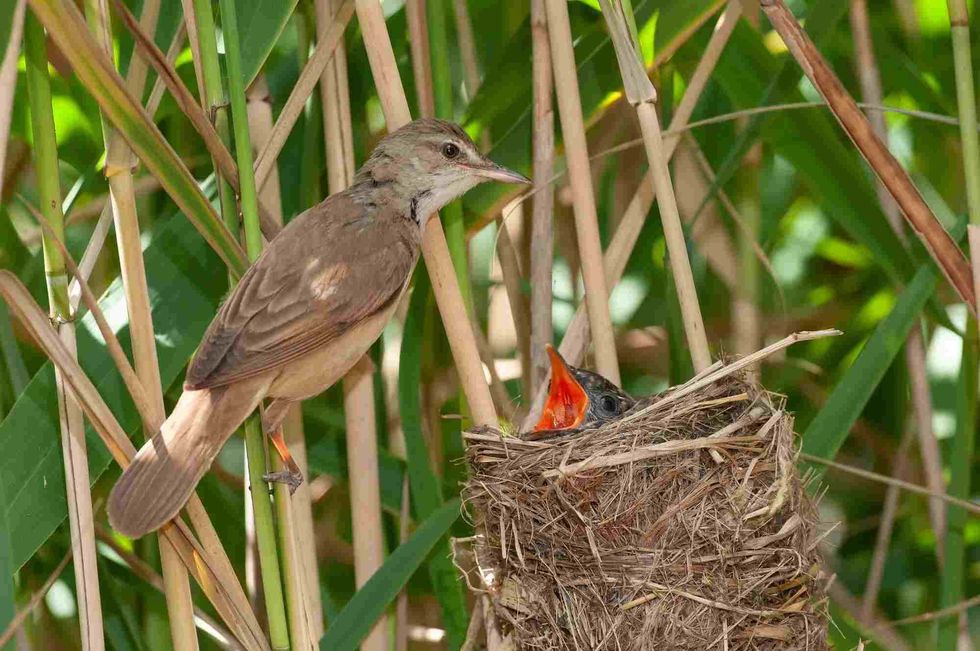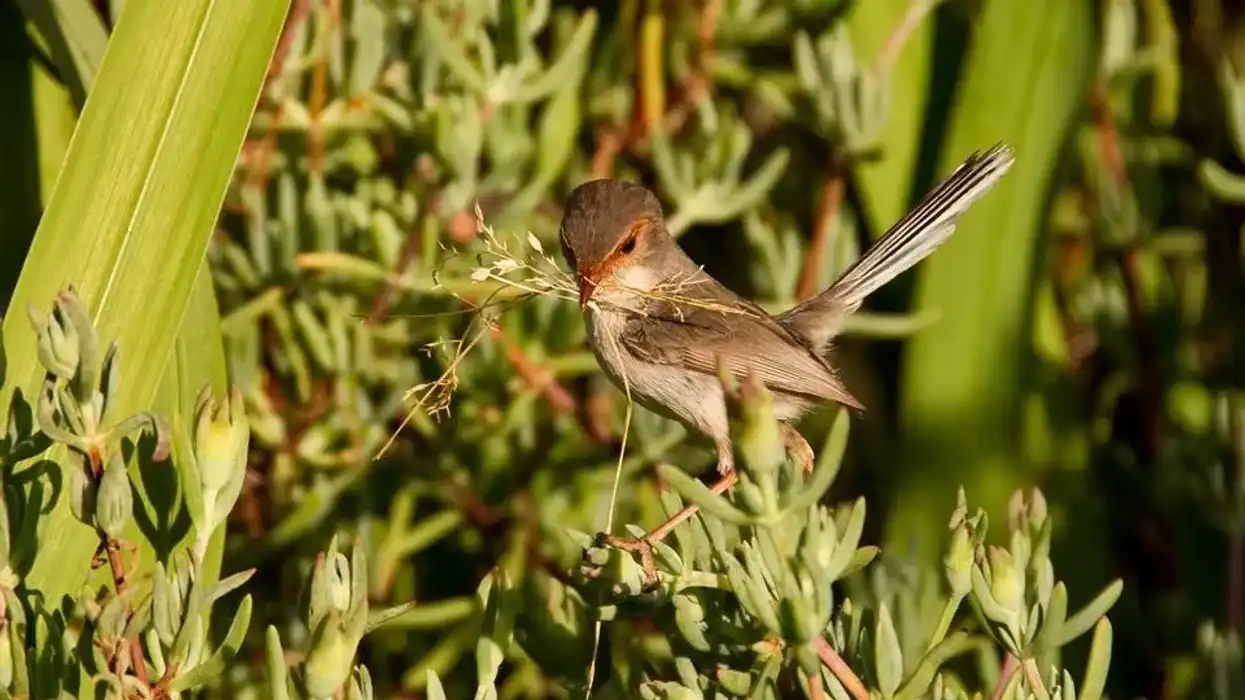The great reed warbler (Acrocephalus arundinaceus) is a medium-sized bird species that has a migratory behaviour. They travel from the European countries in the north to Africa in the south in groups during winters.
This bird species can exhibit both monogamous and polygamous mating behavior. They are known for their melodious song and are a favorite of bird-watchers.
These carnivorous birds are good predators, attacking with their sharp bills, but cause no harm to humans. The IUCN Red List states that this bird species has a conservation status of Least Concern at present as they can survive in a range of warmer habitats around the world.
A male bird woos a female by singing a song before mating. Females breed five to six eggs which are nourished until they mature.
Intrigued to check out more about the life of a great reed warbler (Acrocephalus arundinaceus)? Read on to know more. You can also check interesting facts about the cyprus warbler and Dartford warbler here.
Great Reed Warbler Interesting Facts
What type of animal is a great reed warbler?
The great reed warbler (Acrocephalus arundinaceus) is a bird species with their distribution in Eastern Europe and Africa. Male great reed warblers birds can sing a song in two different ways to attract females or to fight with other males.
What class of animal does a great reed warbler belong to?
The great reed warbler (scientific name Acrocephalus arundinaceus) belongs to the class of Aves. They are the largest reed warbler bird species in the world, belonging to the Acrocephalidae family.
How many great reed warblers are there in the world?
At present, the exact population number of great reed warblers (Acrocephalus arundinaceus) is unknown. However, there are many of these birds existing in the world.
Where does a great reed warbler live?
Grreat reed warblers are a passerine bird species native to the European world. This bird is usually found in Eastern European countries like Sweden, Spain, Poland, Slovakia and around the eastern Baltic Sea. To escape the frigid winter temperatures, they migrate south to tropical Africa and live there until the spring season between March to April.
What is a great reed warbler's habitat?
Great reed warblers live in a range of habitats like grass plains, beds of reeds, woodlands, shrublands, marshes, small water bodies, and forest clearings.
Who do great reed warblers live with?
Great reed warblers of the world are found to live solitary or in pairs in Europe. They are seen to be living in a group in their wintering habitat.
How long does a great reed warbler live?
The lifespan of great reed warbler (Acrocephalus arundinaceus) birds is around two and a half years in the wild.
How do they reproduce?
Males and females of this bird species (Acrocephalus arundinaceus) can form both monogamous and polygamous pairs for breeding. Breeding typically occurs in the warmer months, between April to August in the north (Europe) and winters in the south (tropical Africa).
They prefer a marshy area of reeds or near a lake region to mate. The females lay three to six eggs in their region of stay at the time of breeding. They build a cup-shaped nest on their own, while male partners guard the nest.
The mother incubates the eggs for 14 days after which the eggs hatch. The nestlings stay under the care of their parents until they attain independence after two weeks.
What is their conservation status?
At present, the great reed warbler (Acrocephalus arundinaceus) is listed as a species of Least Concern in the IUCN Red List. There are no serious threats to their survival in the wild. Bird lovers love listening to their melodious song, so there is no threat from humans either.
Great Reed Warbler Fun Facts
What do great reed warblers look like?
The great reed warbler (Acrocephalus arundinaceus) is a medium in size bird species having a feather-covered body. Their wings are long and become pointy towards the end. The upper parts are darker in color having a brown to brownish-black hue and the underside and throat area are whitish.
The transition shade between these two areas is an ochre-yellow color. Their head is big and is slightly tilted upwards. The bill is pointy and sharp for catching prey.
 * We've been unable to source an image of great reed warbler and have used an image of reed warbler instead. If you are able to provide us with a royalty-free image of great reed warbler, we would be happy to credit you. Please contact us at hello@kidadl.com.
* We've been unable to source an image of great reed warbler and have used an image of reed warbler instead. If you are able to provide us with a royalty-free image of great reed warbler, we would be happy to credit you. Please contact us at hello@kidadl.com.
How cute are they?
The great reed warbler (Acrocephalus arundinaceus) is an adorable-looking bird species, with its upward-tilted head and sharp, pointy beak. Bird lovers find this bird even cuter when it sings its melodious song.
How do they communicate?
Great reed warblers can communicate acoustically. Whistling and singing a song that sounds like 'carr-carr-cree-cree-cree-jet-jet' is their form of interaction.
To attract a female, a male sings a long and loud song. A short song is usually sung by a male to ward off other males from its territory. While these birds fight, they keep on interacting with a short and continuous song.
The type of communication also varies between a monogamous and polygamous species of these birds. While a monogamous male sings a long song to attract a female, a polygamous pair does so with a short and repetitive song.
How big is a great reed warbler?
The size of the great reed warbler (Acrocephalus arundinaceous) is 6.3-8.3 in (16-21 cm) by length, having a wingspan of 9.9-11.8 in (25-30 cm). This bird species is three times bigger than sparrows.
How fast can a great reed warbler fly?
The exact speed of this bird species (Acrocephalus arundinaceus) is unknown. However, considering their world distribution in Europe and Africa, they can be treated as fast-flyers in a group.
How much does a great reed warbler weigh?
The average weight of a great reed warbler falls between 0.78-1.34 oz (22-38 g).
What are the male and female names of the species?
Great reed warbler males and females are not known by any specific names.
What would you call a baby great reed warbler?
A baby great reed warbler is called a nestling.
What do they eat?
The great reed warbler is a carnivorous bird species. Their diet is mostly insectivorous preying on different insects and their larvae. Other foods range from moths, butterflies, spiders, smaller fish, frogs, beetles, dragonflies to snails.
Are they dangerous?
The great reed warbler species is not known to be harmful to humans. They are great predators of their prey and can attack with their sharp beaks. While fighting with other warblers, a male often sings a short and aggressive song to protect its territory.
Would they make a good pet?
It is not advisable to keep the great reed warbler as a pet at home. These adorable birds can survive best in the wild, amidst nature, singing a beautiful song. Caging these birds at home and depriving them of their typical birdlife is not appropriate.
Did you know...
In polygamous species, sometimes a different male attains the role of a stepfather who looks after the offspring. They are called 'satellite' fathers.
They belong to the Acrocephalus genus, which in Greek means 'a bird having a high and pointy head, staying amidst reeds'.
Research suggests that the two allopatric populations of the great reed warbler, living in southeastern and southwestern Europe were separated more than 80,000 years ago due to the advancement of the Vistulian-Wurm ice sheets during the last glacial period.
Where do reed warblers go in winter?
Great reed warblers cannot withstand the harsh northern winters of Europe. They migrate down south to the tropical countries of Africa in groups. Right after the winters of Europe end, all of these birds migrate back to the north by the end of April from Africa. These birds are not endemic.
What calls do great reed warblers make?
The song of the great reed warbler (Acrocephalus arundinaceus) is rhythmic by nature making a sound like 'carr-carr-cree-cree-cree-jet-jet'. While a longer and louder song is sung by male birds to find and attract suitable partners, short and repetitive calls are indicative of two or more birds fighting amongst each other to defend one's territory.
Here at Kidadl, we have carefully created lots of interesting family-friendly animal facts for everyone to discover! Learn more about some other birds from our yellow crowned amazon facts and lilac-crowned amazon facts pages.
You can even occupy yourself at home by colouring in one of our free printable great reed warbler coloring pages.




 * We've been unable to source an image of great reed warbler and have used an image of reed warbler instead. If you are able to provide us with a royalty-free image of great reed warbler, we would be happy to credit you. Please contact us at hello@kidadl.com.
* We've been unable to source an image of great reed warbler and have used an image of reed warbler instead. If you are able to provide us with a royalty-free image of great reed warbler, we would be happy to credit you. Please contact us at hello@kidadl.com.




